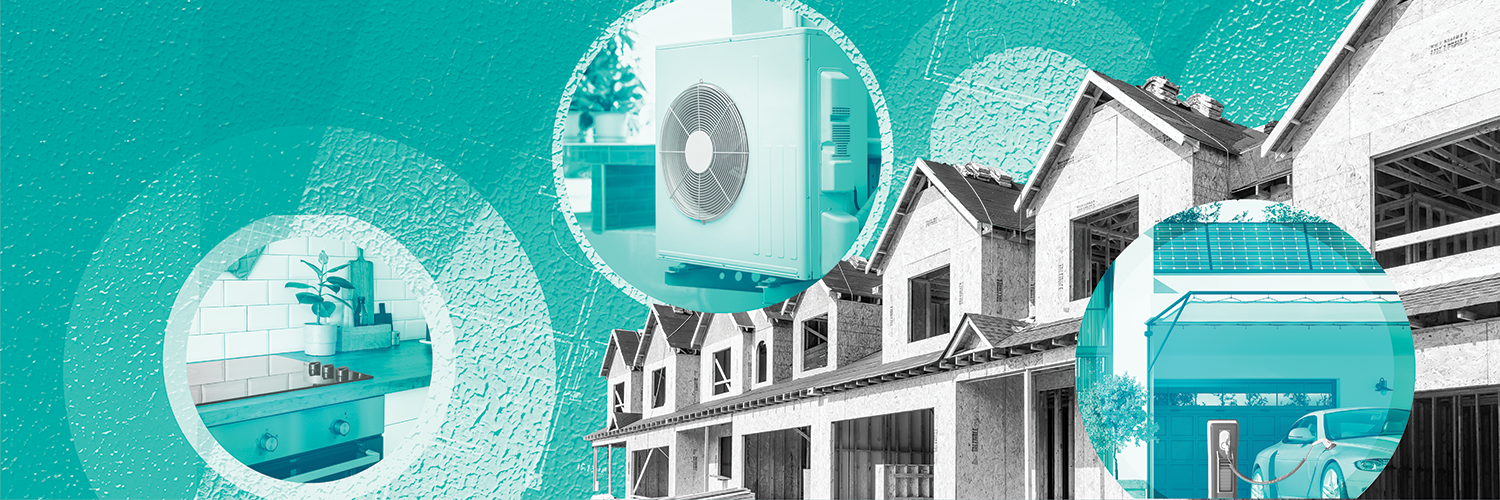 In order to help federal, state, and local action plans reach their decarbonization goals, ILLUME looked into ways to promote the adoption of new technologies and all-electric home construction through market transformation programs.
In order to help federal, state, and local action plans reach their decarbonization goals, ILLUME looked into ways to promote the adoption of new technologies and all-electric home construction through market transformation programs.
The Challenge
Decarbonization is the cornerstone of many climate action plans and many utilities have implemented decarbonization targets. The building sector is a key component of decarbonization strategies, and new, single-family homes, in particular, can play a key role in reaching decarbonization goals. However, the current market does not widely favor all-electric new homes for many reasons. While we have the technologies needed to decarbonize our building stock, the challenge lies in pushing large-scale implementation that transforms the market.
The ILLUME team investigated market transformation models that would increase the adoption of all-electric homes in the new construction market. This study’s goal was to identify the program structure that is most effective in motivating market transformation for single-family homes: a whole-home or an equipment-only approach. Programs based on whole-home approaches would incentivize only the full electrification of a new home. Whereas an equipment-only approach, individual technologies would be incentivized, including technology for HVAC, cooking, and water heating end uses.
The Approach
In 2022, an electric utility client started exploring market transformation programs for new home construction and asked ILLUME to help them better understand program approaches and next steps. The utility and ILLUME developed five specific questions focused on the two distinct—whole-home and equipment-only—program models.
Original Research Questions
- From a market transformation (MT) perspective, which would be more successful in advancing the single-family all-electric new construction market? a) a whole-home program, b) a program(s) for the individual technologies used in Electric New Home Construction (heat pumps, heat pump water heaters, induction ranges, window/envelope measures, lighting controls, etc.), or c) a hybrid approach?
- How would the energy and bill savings created under an all-electric single-family new construction program differ from the sum of savings from an end-user-specific MT program(s) for the individual technologies?
- How would market intervention strategies differ?
- Would separate logic models be needed for an individual technology approach?
- What does an evaluation of a whole-home MT program look like?
To answer these questions, the ILLUME Team designed a research scope that included primary and secondary research tasks. First, we developed a conceptual program logic model that would serve as a basis for a market transformation program targeting single-family new construction. From there, we identified that we needed to understand the regional market before attempting to answer these questions. Our team conducted a host of primary and secondary research tasks to investigate and understand the regional new home construction market.
As part of this work, the ILLUME team:

- Reviewed new construction programs across the country, their logic models, and program evaluation approaches.
- Interviewed local home builders, raters, realtors, architects, HVAC manufacturers, new construction program implementors, and the regional Green Building Organization.
- Defined and mapped key new residential market actors and their decision-making dynamics.
- Developed a conceptual program logic model for a whole-home program approach.
The Results
ILLUME found that a whole-home approach, as opposed to equipment-only, would engage more market actors and address the barriers to new home electrification more effectively.
The whole-home market transformation program:
- Encourages fully electric homes: To receive the incentive, it would be required that all systems and appliances in the home be electric. However, there can be higher construction costs, either from equipment or enhanced envelopes, that need to be investigated more.
- Has a simplified program design for ease of implementation and participation: A single application is submitted, and one incentive is distributed per electric home built rather than individual incentives for each appliance, HVAC, and water heating system. Implementers interviewed stressed that a simple application and incentive process is important for a new construction program given builders’ busy schedules.
- Supports optimized equipment sizing: Due to cold-climate comfort concerns with heat pumps, we heard that some contractors upsize equipment, and therefore increase the cost, to compensate for leaky home envelopes. By including envelope considerations in a whole-home approach, contractors may be better able to right-size equipment selection, reducing electric equipment costs.
- Offers a clearer program influence: The attribution of savings may be more streamlined in a whole-home versus equipment approach.

The Takeaway
A whole-home approach can more effectively include key market actors and better enable market transformation (read our case study on how market actors can spur all-electric home new construction here).
Building envelope and energy efficiency need to be integrated components of any home electrification effort. A whole-home program approach more effectively ensures that high-efficiency building envelopes and systems are part of electric new construction.
New construction incentives and technical assistance programs can align with state and local building energy codes and stretch codes and create a greater force for new construction market transformation.
